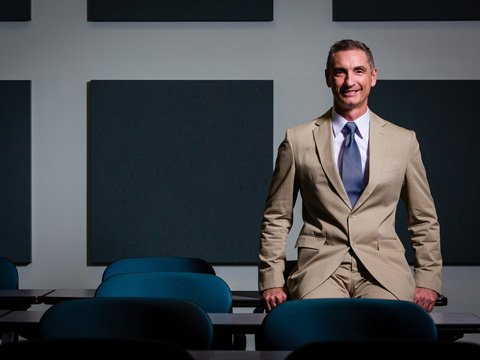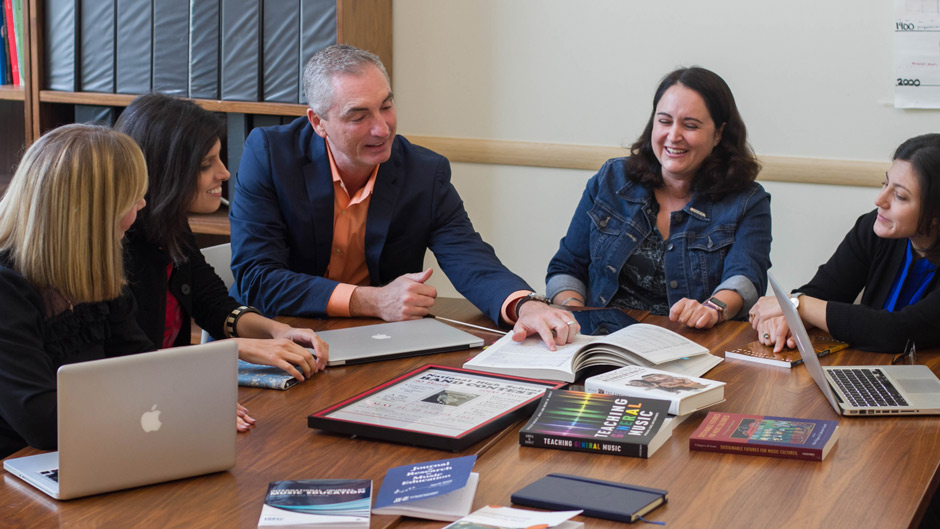High school is perhaps the most impactful time in a person’s life—for Carlos Abril, it was the time he discovered his love for music.
“Studying music in school opened many doors for me. It offered a means for self-expression and for finding meaning through performance and creative music-making,” said Abril, professor of music education and associate dean of research at the Frost School of Music.
 It was that passion for music that led him to a career path that strived to teach others about the importance of music. Throughout his time at the University of Miami, Abril has conducted extensive research focusing on sociocultural issues in music education, music education policy, and music perception. Most recently, Abril published research in the Journal of Research in Music Education that aims to make music study available and accessible to all students in high schools. The study was co-authored by Kenneth Elpus from the University of Maryland.
It was that passion for music that led him to a career path that strived to teach others about the importance of music. Throughout his time at the University of Miami, Abril has conducted extensive research focusing on sociocultural issues in music education, music education policy, and music perception. Most recently, Abril published research in the Journal of Research in Music Education that aims to make music study available and accessible to all students in high schools. The study was co-authored by Kenneth Elpus from the University of Maryland.
“The goal of the study was, in part, to find out how student demographic characteristics, such as socioeconomic status, race, ethnicity, and linguistic background, predict enrollment in specific types of high school music courses, and what we found was illuminating,” Abril said.
The study constructed a complete demographic profile of high school music ensemble students using nationally represented data for the U.S. graduating high school class of 2013. Results found that choir was the most popular course with 13 percent of students enrolling, band followed closely with 11 percent of enrollment, and orchestra trailed far behind with only 2 percent of students nationally enrolling. The overall participation rate in high school music courses across the country has remained relatively stable over the last thirty years.
“Unlike choirs, which we found to be representative of the general student body on all variables but gender, we found that students in instrumental music courses are not reflective of the general student body on variables including race/ethnicity, socioeconomic status, and prior academic achievement. Of concern was the fact that African-American and Latino students were significantly underrepresented in high school instrumental programs across the U.S.,” said Abril.
Another key finding was that students of a lower socioeconomic status were less likely to participate in instrumental music education than their higher socioeconomic status peers. Overall, the study found that the racial and ethnic composition of music ensemble students was 58 percent white, 13 percent black or African American, 17 percent Hispanic or Latino, 4 percent Asian or Pacific Islander, and under 1 percent American Indian or Alaska Native.
Abril believes that understanding who is represented and underrepresented in the most commonly offered music courses in U.S. secondary schools might help pinpoint problems of access and equity.
“The goal is to make music study in school available to all students. Policy makers and music educators need to ensure no child is left behind. For many students whose families cannot afford private lessons, formal music study in school may be the only opportunity to learn to compose music, play an instrument, or sing in a choir,” said Abril.
Growing up as a Latino male in the profession, his topic of research hits close to home.
“I was someone who benefited greatly from the study of music in school. This ignited my research interest in examining ways that music education can be made more culturally responsive, equitable, and accessible for all students. I believe strongly that all students, regardless of their financial circumstances, cultural backgrounds, and abilities, have a right to a quality music education,” he said.
He hopes this study will help music educators become aware of the needs of their community.
“We at the Frost School of Music are keen on preparing the next generation of music educators to construct school programs that best serve the needs of students and the communities where they live,” he said.

